Josephine Baker
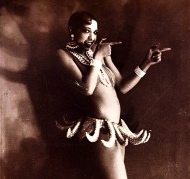
Josephine Baker
From KETC, LIVING ST. LOUIS Producer Ruth Ezell takes a special look back at the life of Josephine Baker, the first African-American female to reach international stardom. Born in St. Louis in 1906, it was Baker’s early years marked by poverty and transience that influenced her most. She lived in a racially divided neighborhood but would hang out in the entertainment district—watching performances that she could imitate on the streets for money. Baker’s big break came when she moved to France and danced topless in a banana skirt. Despite her world-wide success, Baker used her celebrity status to break down racial barriers and focus on humanitarian efforts.
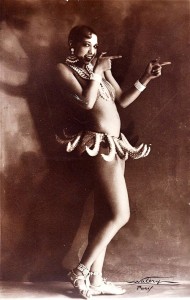 Josephine Baker in her famous banana costume.
Josephine Baker in her famous banana costume.
Josephine Baker (born June 3, 1906 – died April 12, 1975) was an American-born French dancer, singer, and actress who came to be known in various circles as the “Black Pearl,” “Bronze Venus” and even the “Creole Goddess”. Born Freda Josephine McDonald in St. Louis, Missouri, Josephine later became a citizen of France in 1937. She was fluent in both English and French.
Baker was the first black woman to star in a major motion picture, Zouzou (1934) or to become a world-famous entertainer. Baker, who refused to perform for segregated audiences in America, is also noted for her contributions to the Civil Rights Movement. She was once offered unofficial leadership in the movement in the United States by Coretta Scott King in 1968, following Martin Luther King, Jr.’s assassination. Baker, however, turned down the offer. She was also known for assisting the French Resistance during World War II, and received the French military honor, the Croix de guerre and was made a Chevalier of the Légion d’honneur by General Charles de Gaulle.
Early Life
Josephine Baker was born Freda Josephine McDonald in St. Louis, Missouri, the daughter of Carrie McDonald. Her estate identifies vaudeville drummer Eddie Carson as her natural father; Carson abandoned Baker and her mother.
Carrie and Eddie had a song-and-dance act, playing wherever they could get work, and when Josephine was about a year old they began to carry her onstage occasionally during their finale.
Josephine was always poorly dressed and hungry, and her playground became the yards of Union Station. From this she developed her street smarts.
When Baker was eight she began working as a live-in domestic for white families in St. Louis.[7] She was sent to work for a woman who abused her, burning Baker’s hands when she put too much soap in the laundry.
Career – Early Years
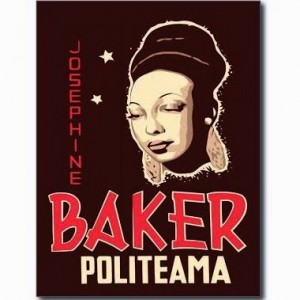 Baker dropped out of school at the age of 13 and lived as a street child in the slums of St. Louis, sleeping in cardboard shelters and scavenging for food in garbage cans.
Baker dropped out of school at the age of 13 and lived as a street child in the slums of St. Louis, sleeping in cardboard shelters and scavenging for food in garbage cans.
Her street-corner dancing attracted attention and she was recruited for the St. Louis Chorus vaudeville show at the age of 15.
She then headed to New York City during the Harlem Renaissance, performing at the Plantation Club and in the chorus of the groundbreaking and hugely successful Broadway revues Shuffle Along (1921) with Adelaide Hall and The Chocolate Dandies (1924). She performed as the last dancer in a chorus line, a position where, traditionally, the dancer performed in a comic manner, as if she were unable to remember the dance, until the encore, at which point she would perform it not only correctly but with additional complexity.
Baker was then billed as “the highest-paid chorus girl in vaudeville.”
Paris and rise to fame
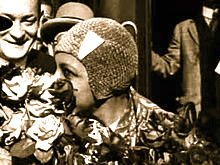 Arrival of Josephine Baker in The Hague in 1928
Arrival of Josephine Baker in The Hague in 1928
She traveled to Paris, France, for a new venture, and opened in “La Revue Nègre” on October 2, 1925, at the Théâtre des Champs-Élysées.
In Paris, she became an instant success for her erotic dancing and for appearing practically nude on stage.
After a successful tour of Europe, she broke her contract and returned to France to star at the Folies Bergère, setting the standard for her future acts.
She performed the Danse sauvage, wearing a costume consisting of a skirt made of a string of artificial bananas. Her success coincided (1925) with the Exposition des Arts Décoratifs which gave birth to the term “Art Deco,” and also with a renewal of interest in non-western forms of art, including African.
Baker represented one aspect of this fashion. In later shows in Paris, she was often accompanied on stage by her pet cheetah, Chiquita, who was adorned with a diamond collar. The cheetah frequently escaped into the orchestra pit, where it terrorized the musicians, adding another element of excitement to the show.
After a short while, Baker was the most successful American entertainer working in France. Ernest Hemingway called her “the most sensational woman anyone ever saw.”
In addition to being a musical star, Baker also starred in three films which found success only in Europe: the silent film Siren of the Tropics (1927), Zouzou (1934) and Princesse Tam Tam (1935). She also starred in Fausse Alerte in 1940.[15]
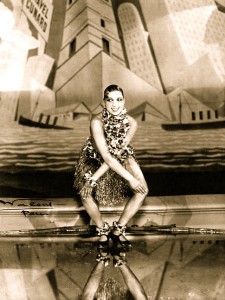 Josephine Baker dancing the Charleston, 1926
Josephine Baker dancing the Charleston, 1926
At this time she also scored her most successful song, “J’ai deux amours” (1931), and became a muse for contemporary authors, painters, designers and sculptors, including Langston Hughes, Ernest Hemingway, F. Scott Fitzgerald, Pablo Picasso, and Christian Dior.
Under the management of Giuseppe Pepito Abatino — a Sicilian former stonemason who passed himself off as a count — Baker’s stage and public persona, as well as her singing voice, were transformed.
In 1934, she took the lead in a revival of Jacques Offenbach’s opera La créole, which premiered in December of that year for a six-month run at the Théâtre Marigny on the Champs-Élysées of Paris. In preparation for her performances, she went through months of training with a vocal coach.
In the words of Shirley Bassey, who has cited Baker as her primary influence, “… she went from a ‘petite danseuse sauvage’ with a decent voice to ‘la grande diva magnifique’… I swear in all my life I have never seen, and probably never shall see again, such a spectacular singer and performer.”
 Despite her popularity in France, Baker never obtained the same reputation in America.
Despite her popularity in France, Baker never obtained the same reputation in America.
Upon a visit to the United States in 1935–36, American audiences rejected the idea that a black woman could be so sophisticated; her star turn in the Ziegfeld Follies generated less than impressive box office numbers, and she was replaced by Gypsy Rose Lee later in the run. Time magazine referred to her as a “Negro wench.” She returned to Europe heartbroken.
Baker returned to Paris in 1937, married a Jewish Frenchman, Jean Lion, and became a French citizen. They were married in the French town of Crèvecœur-le-Grand. The wedding was presided over by the mayor at the time, Jammy Schmidt.
It has been claimed that when, during the ceremony, she was asked if she was ready to give up her American citizenship, she renounced it without difficulty.
Work during World War II
In September 1939, when France declared war on Germany in response to the invasion of Poland, Baker was recruited by Deuxième Bureau, French military intelligence, as an “honorable correspondent”. Baker collected what information she could about German troop locations from officials she met at parties. She specialized in gatherings at embassies and ministries, charming people as she had always done, while gathering information. Her café-society fame enabled her to rub shoulders with those in the know, from high-ranking Japanese officials to Italian bureaucrats, and to report back what she heard. She attended parties at the Italian embassy without any suspicion falling on her and gathered information.
When the Germans invaded France, Baker left Paris and went to the Château des Milandes, her home in the south of France. She housed friends who were eager to help the Free French effort led by Charles de Gaulle and supplied them with visas. As an entertainer, Baker had an excuse for moving around Europe, visiting neutral nations such as Portugal and some in South America, carrying information for transmission to England, about airfields, harbors, and German troop concentrations in the West of France. It would be written in invisible ink on Josephine’s sheet music.
Later in 1941, she and her entourage went to the French colonies in North Africa; the stated reason was Baker’s health (since she really was recovering from another case of pneumonia) but the real reason was to continue helping the Resistance. From a base in Morocco, she made tours of Spain and pinned notes with the information she gathered inside her underwear (counting on her celebrity to avoid a strip search) and made friends with the Pasha of Marrakesh, whose support helped her through a miscarriage (the last of several). After the miscarriage she developed an infection so severe it required a hysterectomy. However, the infection was not contained and she developed peritonitis and then septicemia. After her recovery (which she continued to fall in and out of), she started touring to entertain British, French, and American soldiers in North Africa. The Free French had no organized entertainment network for their troops so Baker and her friends managed for the most part on their own with no civilians and no admission charge. To this day, veterans greatly remember her performances.
In Cairo, Egypt’s King Farouk asked her to sing to which she refused because Egypt had not recognized Free France and remained neutral. However, she offered to sing in Cairo at a celebration of honor for the ties between Free France and Egypt and asked Farouk to preside, a subtle indication of which side his officially neutral country leaned toward.
After the war, for her underground activity, Baker received the Croix de guerre and the Rosette de la Résistance, and was made a Chevalier of the Légion d’honneur by General Charles de Gaulle.
Later Career
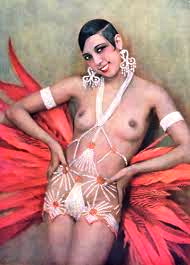 In 1949, a reinvented Baker returned in triumph to the Folies Bergere. Bolstered by recognition of her wartime heroics, Baker the performer assumed a new gravitas, unafraid to take on serious music or subject matter. The engagement was a rousing success, and reestablished Baker as one of Paris’ preeminent entertainers.
In 1949, a reinvented Baker returned in triumph to the Folies Bergere. Bolstered by recognition of her wartime heroics, Baker the performer assumed a new gravitas, unafraid to take on serious music or subject matter. The engagement was a rousing success, and reestablished Baker as one of Paris’ preeminent entertainers.
The year 1951 saw Baker invited back to the US for a nightclub engagement in Miami. After winning a public battle over desegregating the club’s audience, Baker followed up her sold-out run at the club with a national tour. Rave reviews and enthusiastic audiences accompanied her everywhere, climaxed by a parade in front of 100,000 people in Harlem in honor of Baker’s new title: the NAACP’s Woman of the Year. Baker’s short-term future looked bright — six months of bookings lay ahead, with promises of much more to come. An incident at the Stork Club, however (see below), brought all of Baker’s plans to an abrupt halt. Baker criticized columnist Walter Winchell, an old ally of Baker’s, for not rising to her defense; Winchell responded swiftly with a series of harsh rebukes. The ensuing publicity resulted in the termination of Baker’s work visa, forcing her to cancel all her future engagements and eventually return to France. It was almost a decade before US officials allowed Baker back into the country.
In January 1966, Fidel Castro invited Baker to perform at the Teatro Musical de La Habana in Havana, Cuba at the 7th anniversary celebrations of his revolution. Her spectacular show in April broke attendance records. In 1968, Baker visited Yugoslavia and made appearances in Belgrade and in Skopje.
In her later career, Baker faced money troubles and made comments like, “Nobody wants me, they’ve forgotten me.” However, family members encouraged her to continue performing. As a result in 1973, she opened at Carnegie Hall to a standing ovation, and in 1974, she appeared in a Royal Variety Performance at the London Palladium. That same year, Baker performed at the Monacan Red Cross Gala, celebrating the forthcoming anniversary for her 50 years in French show business. With Josephine’s advancing years, and with exhaustion, her memory was becoming unreliable. Sometimes she had trouble remembering the words of her songs, and her speeches between them tended to ramble, nonetheless she continued to captivate audiences regardless of their age.
Civil Rights Activism
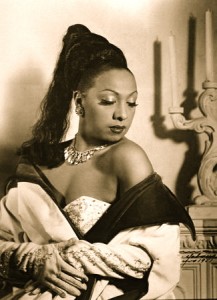 Josephine Baker in Havana, Cuba, 1950
Josephine Baker in Havana, Cuba, 1950
Although based in France, Baker supported the American Civil Rights Movement during the 1950’s. When she arrived in New York with her husband Jo they were refused reservations at 36 hotels because she was black. She was so upset by the treatment that she wrote articles on the segregation in the United States and began traveling farther south. She gave a talk at the all-black Fisk University in Nashville, Tennessee, her subject being “France, North Africa And The Equality Of The Races In France.” In addition, she refused to perform for segregated audiences in the United States even after she was offered $10,000 by a Miami club (The club eventually met her demands). Her insistence on mixed audiences helped to integrate shows in Las Vegas, Nevada, then one of the most segregated cities in America.[11] After this incident, she began receiving threatening phone calls from the Ku Klux Klan but stated that she was not afraid of them.
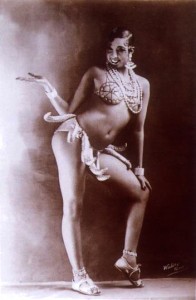 Baker pictured in her most famous costume for the Danse banane
Baker pictured in her most famous costume for the Danse banane
In 1951, Baker made charges of racism against Sherman Billingsley’s Stork Club in Manhattan, where she alleged that she had been refused service. Actress Grace Kelly, who was at the club at the time, rushed over to Baker, took her by the arm and stormed out with her entire party, vowing never to return (although she did in fact appear there on January 3, 1956 with Prince Rainier of Monaco). The two women became close friends after the incident. Testament to this was made evident when Baker was near bankruptcy and was offered a villa and financial assistance by Kelly (who by then was princess consort of Rainier III of Monaco). (However, during his work on the Stork Club book, author and New York Times reporter Ralph Blumenthal was contacted by Jean-Claude Baker, one of Josephine Baker’s sons. Having read a Blumenthal-written story about Leonard Bernstein’s FBI file, he indicated that he had read his mother’s FBI file and, using comparison of the file to the tapes, said he thought the Stork Club incident was overblown.
Baker worked with the NAACP. Her reputation as a crusader grew to such an extent that the NAACP had Sunday 20 May 1951 declared Josephine Baker Day. She was presented with life membership of the NAACP by Nobel Peace Prize winner Dr. Ralph Bunche. The honor she was paid spurred her to further her crusading efforts with the “Save Willie McGee” rally and the 1948 beating of the furniture shop owner in Trenton, New Jersey. As Josephine became increasingly regarded as controversial, even many blacks began to shun her, fearing that her reputation would hurt their cause.
In 1963, she spoke at the March on Washington at the side of Martin Luther King, Jr. Baker was the only official female speaker and while wearing her Free French uniform emblazoned with her medal of the Légion d’honneur she introduced the “Negro Women for Civil Rights.” Rosa Parks and Daisy Bates were among those she acknowledged and both gave brief speeches. After King’s assassination, his widow Coretta Scott King approached Baker in the Netherlands to ask if she would take her husband’s place as leader of the American Civil Rights Movement. After many days of thinking it over, Baker declined, saying her children were “too young to lose their mother.”
Personal Life – Relationships
Baker was married four times. Her first marriage was to pullman porter Willie Wells when she was just 13 years old. The marriage was reportedly a very unhappy one and the couple divorced a short time later. She married Willie Baker in 1921 but that marriage also was short-lived. She retained that last name simply because her career began taking off during that time, and it was the name by which she became best known. In 1937, she married Frenchman Jean Lion, during which time she received French citizenship and became a permanent expatriate. She and Lion separated before he passed away. In 1947, she married French composer Jo Bouillon whom she also divorced. She was later involved for a time with artist Robert Brady, but they never married. Her adopted son Jean-Claude Baker describes his mother as a bisexual, having had relationships with men and women.
Children
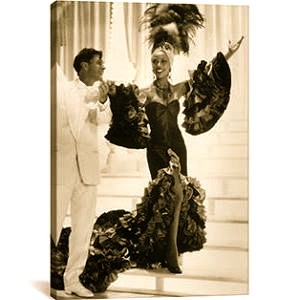 During Baker’s work with the Civil Rights Movement she began adopting children, forming a family she often referred to as “The Rainbow Tribe.” Josephine wanted to prove that “children of different ethnicities and religions could still be brothers.” She often took the children with her cross-country, and when they were at Château des Milandes tours were arranged so visitors could walk the grounds and see how natural and happy the children in “The Rainbow Tribe” were. Baker raised two daughters, French-born Marianne and Moroccan-born Stellina, and ten sons, Korean-born Jeannot (or Janot), Japanese-born Akio, Colombian-born Luis, Finnish-born Jari (now Jarry), French-born Jean-Claude and Noël, Israeli-born Moïse, Algerian-born Brahim, Ivorian-born Koffi, and Venezuelan-born Mara. For some time, Baker lived with her children and an enormous staff in a castle, Château des Milandes, in Dordogne, France, with her fourth husband French conductor Jo Bouillon.
During Baker’s work with the Civil Rights Movement she began adopting children, forming a family she often referred to as “The Rainbow Tribe.” Josephine wanted to prove that “children of different ethnicities and religions could still be brothers.” She often took the children with her cross-country, and when they were at Château des Milandes tours were arranged so visitors could walk the grounds and see how natural and happy the children in “The Rainbow Tribe” were. Baker raised two daughters, French-born Marianne and Moroccan-born Stellina, and ten sons, Korean-born Jeannot (or Janot), Japanese-born Akio, Colombian-born Luis, Finnish-born Jari (now Jarry), French-born Jean-Claude and Noël, Israeli-born Moïse, Algerian-born Brahim, Ivorian-born Koffi, and Venezuelan-born Mara. For some time, Baker lived with her children and an enormous staff in a castle, Château des Milandes, in Dordogne, France, with her fourth husband French conductor Jo Bouillon.
Later Years and Death
 In 1964, Josephine Baker lost her castle due to unpaid debts; after, Princess Grace offered her an apartment in Roquebrune, near Monaco.
In 1964, Josephine Baker lost her castle due to unpaid debts; after, Princess Grace offered her an apartment in Roquebrune, near Monaco.
Baker was back on stage at the Olympia in Paris in 1968, in Belgrade in 1973, at Carnegie Hall in 1973, at the Royal Variety Performance at the London Palladium in 1974 and at the Gala du Cirque in Paris in 1974. On April 8, 1975, Baker starred in a retrospective revue at the Bobino in Paris, Joséphine à Bobino 1975, celebrating her 50 years in show business. The revue, financed notably by Prince Rainier, Princess Grace, and Jacqueline Kennedy Onassis, opened to rave reviews. Demand for seating was such that fold-out chairs had to be added to accommodate spectators. The opening night audience included Sophia Loren, Mick Jagger, Shirley Bassey, Diana Ross, and Liza Minnelli.
Four days later, Baker was found lying peacefully in her bed surrounded by newspapers with glowing reviews of her performance. She was in a coma after suffering a cerebral hemorrhage. She was taken to Pitié-Salpêtrière Hospital, where she died, aged 68, on April 12, 1975. She received a full Roman Catholic funeral which was held at L’Église de la Madeleine. The only American-born woman to receive full French military honors at her funeral, Baker locked up the streets of Paris one last time. After a family service at Saint-Charles Church in Monte Carlo, Baker was interred at Monaco’s Cimetière de Monaco.

